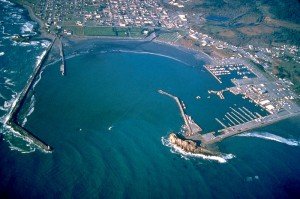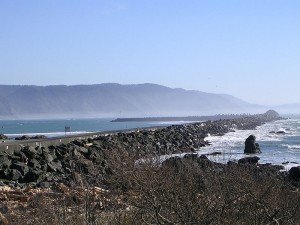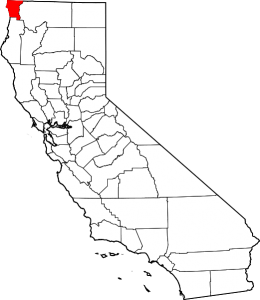Since the devastating Japanese tsunami of 2011, many people came to realize just how damaging an event like this is to a country’s infrastructure.
There is a scenic coastal town in far northern California, very near the Oregon border, that was the scene to one of the worst tsunamis on United States soil. Crescent City California unfortunately is situated at a point where the seabed itself magnifies wave action that can turn a tsunami into a ravaging tidal wave that can engulf almost the entire town. The story of why this is so and the havoc and loss of life it delivered is an interesting story. The year 1964 was a year residents of this coastal community never forgot. At the time it made headlines the world over.The story of Crescent City California is an interesting one.

An earthquake near Anchorage Alaska in 1964 changed the history of the coastal town of Crescent City forever. Wave cycles that were larger than eight feet virtually destroyed this town. The Crescent City Ca tsunami was one of the worst in America’s history. West coast tsunamis have been a danger to contend with ever since the area was settled. All west coast states place great emphasis on tsunami warning systems.
What is a tsunami ? A tsunami is generally defined as a long period wave, or seismic sea wave, caused by an underwater disturbance such as a volcanic eruption or earthquake. A reason was discovered as to why this particular tsunami in 1964 had the devastating effects it delivered. The seafloor around Crescent City is shaped as such that tsunami action is actually focused and magnified. When the earthquake occurred in Alaska, a tidal wave effect not only traveled across the Pacific Ocean but swiftly traveled down the North American continent west coast as well. In a matter of a bit more than three hours the effects of the tidal wave were felt in Washington state. About one and a half hours later the waves were striking Crescent City California, about twenty miles south of the Oregon border. In reality, any seismic event anywhere in the Pacific region, whether it is 1,000 miles or 6,000 miles away, can affect any city or town on the United States west coast. When warning system sensors detect certain undersea pulses after a seismic event, you can count on west coast tsunami warnings to be put in effect.
The devastation at Crescent City was reported as follows. Two hundred and eighty nine buildings were totally destroyed. An enormous one thousands automobiles and twenty five large fishing boats were literally crushed. Twelve people were initially confirmed as dead, one hundred were reported injured and there were many people missing. A total of sixty city blocks were flooded and thirty blocks considered destroyed. Never before had a tsunami wreaked this kind of damage to an American city. The tsunami continued down the California coast but fortunately not with this type of devastating effect. Over the years, west coast tsunami damage has been experienced in many communities in addition to Crescent City.

So what effect does the seafloor off Crescent City California have with tsunami waves? To understand this you need to recognize that the seafloor is not flat. It varies as much as the topography on dry land. There are deep shallow spots, canyons and tops of mountain ranges, all below the waters surface.This undersea layout affects the amount of energy at the various locations as the original tsunami wave gets variously reflected and diffracted on the way. You may already be familiar with the way the water retreats before the tsunami wave hits the shore. Many people have lost their lives by wandering out to areas on the beach that have been exposed by the waters retreat. This is the trough before the wave arrives, and this can cause problems if people go out into previously covered areas when the water retreats before it comes back with considerable force. There are newsreels that have shown this type of water retreat as well as the ensuing large wave that strikes shortly after. Tsunamis are sometimes quite confusing to anticipate from the shoreline. The wave action and massive force involved occur underwater. In other words, it’s not like looking out at the horizon and seeing a giant wave thirty feet high in the distance. The force is underwater and as it approaches the shallower seabed off shore, the level is forced to rise as it is being pushed up higher and higher because of the seabed. It appears more like a constant water level rising than a towering wave.

The effect a tsunami has on boats actually illustrates this. It’s common knowledge that a vessel can ride out a tsunami much better being out at sea than tied up at a dock. At sea, the boat will generally feel a rising of the water as the powerful wave travels underwater beneath it’s hull. If that same vessel was tied up at a dock when the wave hit the shore by rapidly rising, the boat would most likely be destroyed by the severe tossing around and would likely break away from it’s lines. Most observers conclude that a vessel at sea is almost under no threat. By the same token, it is never advisable to try to launch a boat from the dock while a tsunami is already in progress. Five people died in Crescent City in 1964 when they launched a boat near the crest of the fourth wave and were caught in the strong outflow. In fact, it is strongly suggested not to even try to go to a dock to try to secure your boat after the tsunami action has already started. Since the wave action comes in cycles, your chances of being caught in the dock area when another wave cycle comes ashore is great.
As far as warning and preparedness against tsunamis, much has changed since the Crescent City California disaster of 1964. Being educated about what a tsunami really is and it’s characteristics many feel is key to knowing what to do and what not to do. Tsunamis can be misleading because they last for a long time. They usually are not one quick event. There was a large tsunami that hit the California coast in the year 1946.This Aleutian generated tsunami produced waves heights of 12 to 16 feet at Half Moon Bay, Muir Beach, Arena Cove, and Santa Cruz. In Crescent City in 1946, half the deaths happened because they went back too soon. The 1946 Aleutian Tsunami crossed the Pacific, producing waves up to 30 feet high in some locations at the Marquesas Islands in French Polynesia, and even had the power to damage fishing boats in Chile. During the tsunami of 2006, Crescent City almost had some deaths because people went back to check on the boats. They didn’t fully understand that subsequent underwater waves were still lurking offshore. Simply put, the best action to take is to head for high ground and then stay there.

As most people are aware, we now have in place a Pacific Ocean wide tsunami alert system. This system employs undersea sensors that measure the magnitude of underwater wave action. Along with this and to take advantage of the timely information, a communications infrastructure has been established to issue timely alerts to permit evacuation of coastal areas. Tsunami alerts that might be issued for the west coast of the U.S., Alaska and Canada originate from the Alaska Tsunami Warning Center in Palmer Alaska. Obviously, the best way to save lives in a tsunami is to be able to give out warnings far in advance and this is the goal of the current warning systems. The west coast tsunami warning system is today quite extensive.
Warnings of course work best when the initial seismic event that causes the tsunami is far away. When an event occurs across the Pacific, the time a wave would take to reach the west coast of the U.S. is measured in hours. When an earthquake occurs around Alaska, the time to prepare is much much less.
Because of the seabed topography around Crescent City California, the threat of a tsunami will always remain but the much improved warning system in place, both across the Pacific Ocean as well as in the city in particular, will go a long way in providing adequate warning if and when another threat presents itself. The northern California coast is a very beautiful place to visit and Crescent City, along with it’s close proximity to the Redwood National and State Parks remains a very popular tourist attraction. If you’re vacation plans include far northern California, it’s a great addition to your trip planner.
